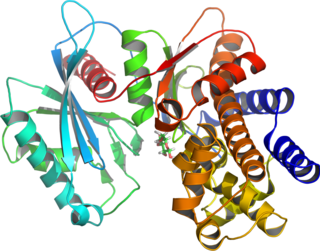Regulatory factor X, 6 also known as DNA-binding protein RFX6 is a protein that in humans is encoded by the RFX6 gene. [5]
Regulatory factor X, 6 also known as DNA-binding protein RFX6 is a protein that in humans is encoded by the RFX6 gene. [5]
The nuclear protein encoded by this gene is a member of the regulatory factor X (RFX) family of transcription factors. Studies in mice suggest that this gene is specifically required for the differentiation of islet cells for the production of insulin, but not for the differentiation of pancreatic polypeptide-producing cells. It regulates the transcription factors involved in beta-cell maturation and function, thus, restricting the expression of the beta-cell differentiation and specification genes.
Mutations in this gene are associated with Mitchell-Riley syndrome, which is characterized by neonatal diabetes with pancreatic hypoplasia, duodenal and jejunal atresia, and gall bladder agenesis. [5]

Glucokinase is an enzyme that facilitates phosphorylation of glucose to glucose-6-phosphate. Glucokinase occurs in cells in the liver and pancreas of humans and most other vertebrates. In each of these organs it plays an important role in the regulation of carbohydrate metabolism by acting as a glucose sensor, triggering shifts in metabolism or cell function in response to rising or falling levels of glucose, such as occur after a meal or when fasting. Mutations of the gene for this enzyme can cause unusual forms of diabetes or hypoglycemia.

Amylin, or islet amyloid polypeptide (IAPP), is a 37-residue peptide hormone. It is cosecreted with insulin from the pancreatic β-cells in the ratio of approximately 100:1 (insulin:amylin). Amylin plays a role in glycemic regulation by slowing gastric emptying and promoting satiety, thereby preventing post-prandial spikes in blood glucose levels.

HNF1 homeobox A, also known as HNF1A, is a human gene on chromosome 12. It is ubiquitously expressed in many tissues and cell types. The protein encoded by this gene is a transcription factor that is highly expressed in the liver and is involved in the regulation of the expression of several liver-specific genes. Mutations in the HNF1A gene have been known to cause diabetes. The HNF1A gene also contains one of 27 SNPs associated with increased risk of coronary artery disease.

PDX1, also known as insulin promoter factor 1, is a transcription factor in the ParaHox gene cluster. In vertebrates, Pdx1 is necessary for pancreatic development, including β-cell maturation, and duodenal differentiation. In humans this protein is encoded by the PDX1 gene, which was formerly known as IPF1. The gene was originally identified in the clawed frog Xenopus laevis and is present widely across the evolutionary diversity of bilaterian animals, although it has been lost in evolution in arthropods and nematodes. Despite the gene name being Pdx1, there is no Pdx2 gene in most animals; single-copy Pdx1 orthologs have been identified in all mammals. Coelacanth and cartilaginous fish are, so far, the only vertebrates shown to have two Pdx genes, Pdx1 and Pdx2.

MHC class II regulatory factor RFX1 is a protein that, in humans, is encoded by the RFX1 gene located on the short arm of chromosome 19.

Paired box gene 4, also known as PAX4, is a protein which in humans is encoded by the PAX4 gene.

Insulin gene enhancer protein ISL-1 is a protein that in humans is encoded by the ISL1 gene.

Nuclear transcription factor Y subunit gamma is a protein that in humans is encoded by the NFYC gene.

Krueppel-like factor 11 is a protein that in humans is encoded by the KLF11 gene.
Neurogenins are a family of bHLH transcription factors involved in specifying neuronal differentiation. It is one of many gene families related to the atonal gene in Drosophila. Other positive regulators of neuronal differentiation also expressed during early neural development include NeuroD and ASCL1.

DNA-binding protein RFX2 is a protein that in humans is encoded by the RFX2 gene.

Transcription factor RFX4 is a protein that in humans is encoded by the RFX4 gene.

Homeobox protein Nkx-2.2 is a protein that in humans is encoded by the NKX2-2 gene.

Transcription factor RFX3 is a protein that in humans is encoded by the RFX3 gene.

Transcription factor MafA is a protein that in humans is encoded by the MAFA gene. It is a member of the Maf family of transcription factors.

Forkhead box protein O1 (FOXO1) also known as forkhead in rhabdomyosarcoma (FKHR) is a protein that in humans is encoded by the FOXO1 gene. FOXO1 is a transcription factor that plays important roles in regulation of gluconeogenesis and glycogenolysis by insulin signaling, and is also central to the decision for a preadipocyte to commit to adipogenesis. It is primarily regulated through phosphorylation on multiple residues; its transcriptional activity is dependent on its phosphorylation state.

Neurogenin-3 is a protein that in humans is encoded by the NEUROG3 gene.

Homeobox protein Nkx-6.1 is a protein that in humans is encoded by the NKX6-1 gene.

ANGPTL8 is a protein that in humans is encoded by the C19orf80 gene.

Pancreatic progenitor cells are multipotent stem cells originating from the developing fore-gut endoderm which have the ability to differentiate into the lineage specific progenitors responsible for the developing pancreas.
This article incorporates text from the United States National Library of Medicine, which is in the public domain.
| This article on a gene on human chromosome 6 is a stub. You can help Wikipedia by expanding it. |